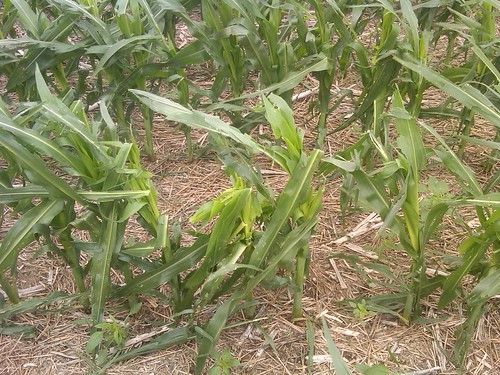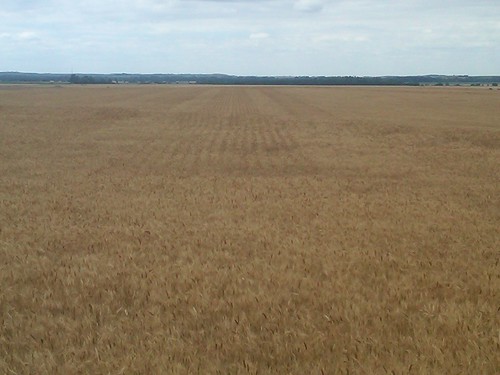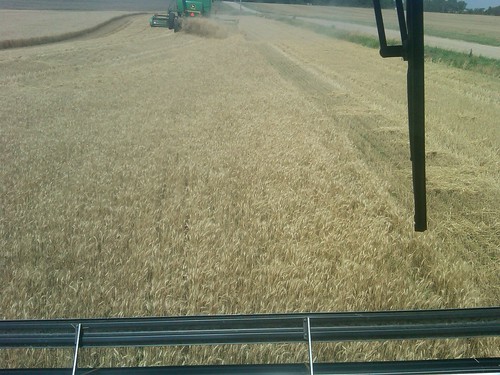I came across this in last week's, July 21, 2011, Minneapolis Messenger's. The Wells News column has a segment titled News from the good old days. They reprint local news stories from the 1930's. With the drought conditions in the southern plains that are reaching into many areas of Kansas in addition to the heat wave we're currently enduring this article about the local wheat harvest in 1937 perked my interest.
Originally published July 1, 1937 on the front page of the Minneapolis Messenger. "Elevators Are Making Record Runs - Wheat is pouring into the market as fast as it can be handled. While Ottawa County was expecting a good crop, no one was expecting as big as a crop as in evidence already. In the eastern part of the state the yield proved a big disappointment. Black rust seems to be the cause of smaller yields. Wheat was bringing $1.03 a bushel and Wednesday morning it was bringing $1.10 a bushel. (1935 and 36 were very dry years and very little wheat was raised. Some brave farmers planted in the fall not knowing if they would get a crop.)" Currently wheat is selling for $7.45 a bushel, it wasn't very many years ago that $4.00 a bushel was considered a very good price.
I'm interested in how the depression and dust bowl effected my local area. My granddad grew up in this era and has passed on a few stories to me about it.While he is still around I need to record more of his stories of farm life in the 30's and 40's.
Monday, July 25, 2011
Heat wave
We are in the grips of the heat wave that is sweeping most of the nation. It's hard on everything outside. Our corn is in the high water use growth stage, it's using .40 inches of water use a day. It can be a challenge keeping irrigation running. Engines that run the pumps and generators can overheat and shut off, we have gauges that will shut off the engines before they're damaged. Our low humidity is increasing the evaporation even with drop nozzles that put water into the corn's canopy.

This is a corn field that has either been put up as hay or chopped for silage. The brown strips are corn that has been left for insurance adjustors to verify loss. Normally the corn would still be green rather than brown. This field is only 80 miles from where we farm.
The corn yields are being hampered by the high temperatures even with adequate water. During pollination the pollen is damaged from the high heat and reduces the kernels that will be on each ear of corn. With temperatures in the low 90's at midnight it's hard for corn to release the water it used earlier in the day to transport nutrients from the soil, this also hampers yields.
Our irrigated soybeans need .30 inches of water a day, but they are getting sacrificed some right now to keep the water on the corn. They are a very resilient crop and if we can get some rain soon they will be fine, the more critical time for them to have water will be in a few weeks when they start setting and filling pods. So there is still time to water them to make a respectable yield.
On a drought tour of extreme southwest Kansas Governor Brownback he was quoted in the news saying. “There’s been less rainfall this year than in the peak of the 1930s Dust Bowl with the same heat and wind. Hats off to the producers for being such good stewards.” This shows just how extreme the drought is in the south western portion of the state. It is also a testament to farming practices that have been implementing since then, we no longer bury the stubble leaving bare soil vulnerable to wind.

This is a corn field that has either been put up as hay or chopped for silage. The brown strips are corn that has been left for insurance adjustors to verify loss. Normally the corn would still be green rather than brown. This field is only 80 miles from where we farm.
The corn yields are being hampered by the high temperatures even with adequate water. During pollination the pollen is damaged from the high heat and reduces the kernels that will be on each ear of corn. With temperatures in the low 90's at midnight it's hard for corn to release the water it used earlier in the day to transport nutrients from the soil, this also hampers yields.
Our irrigated soybeans need .30 inches of water a day, but they are getting sacrificed some right now to keep the water on the corn. They are a very resilient crop and if we can get some rain soon they will be fine, the more critical time for them to have water will be in a few weeks when they start setting and filling pods. So there is still time to water them to make a respectable yield.
On a drought tour of extreme southwest Kansas Governor Brownback he was quoted in the news saying. “There’s been less rainfall this year than in the peak of the 1930s Dust Bowl with the same heat and wind. Hats off to the producers for being such good stewards.” This shows just how extreme the drought is in the south western portion of the state. It is also a testament to farming practices that have been implementing since then, we no longer bury the stubble leaving bare soil vulnerable to wind.
Sunday, July 24, 2011
Report from the farm
Things have been mighty hectic down on the farm since the last time I took time to write. All the spring seeded crops are in, wheat harvest went pretty smooth, and I was able to plant 300 acres of sunflowers in wheat stubble. We did have a hail storm move through at the beginning of wheat harvest, it stripped the leaves off of the corn and knocked wheat out of the heads. Our non irrigated corn which is planted earlier still shows signs of stripped leaves, but the irrigated corn that was still going through a growth spurt and has nice healthy leaves.

This was taken the day after the hail storm. This field had the least damage done to it, but it was still sickening to look at it that morning.
Our wheat yields were average to slightly better. Quality was high, both test weight and protein content was high this year. The standardized weight for wheat is 60 pounds a bushel for number 1 wheat, nearly every load of our wheat had a test weight of 6o or better with many loads 61.5 or better. The protein content of our wheat ranged from 10.5% to 12% with most of it in the 11% range. This is a very good protein content for our region, in the lower rainfall areas of western Kansas.

I took this right before wheat harvest. The darker stripes are a different variety of wheat. I had just a little bit left in the seeder and it mixed with the other seed.

This is the same field at harvest, facing a different direction in this photo. Dad is cutting the terraces, terraces are ridges put made in fields to redirect water to reduce soil erosion. The headers, the part on the front that cuts off the crop, doesn't flex so we have to harvest with the terraces.
I've added various pictures and descriptions to my Flickr account. My photos that I use from my blog are there along with many that I haven't used. The photos range from basic information to more technical issues.

This was taken the day after the hail storm. This field had the least damage done to it, but it was still sickening to look at it that morning.
Our wheat yields were average to slightly better. Quality was high, both test weight and protein content was high this year. The standardized weight for wheat is 60 pounds a bushel for number 1 wheat, nearly every load of our wheat had a test weight of 6o or better with many loads 61.5 or better. The protein content of our wheat ranged from 10.5% to 12% with most of it in the 11% range. This is a very good protein content for our region, in the lower rainfall areas of western Kansas.

I took this right before wheat harvest. The darker stripes are a different variety of wheat. I had just a little bit left in the seeder and it mixed with the other seed.

This is the same field at harvest, facing a different direction in this photo. Dad is cutting the terraces, terraces are ridges put made in fields to redirect water to reduce soil erosion. The headers, the part on the front that cuts off the crop, doesn't flex so we have to harvest with the terraces.
I've added various pictures and descriptions to my Flickr account. My photos that I use from my blog are there along with many that I haven't used. The photos range from basic information to more technical issues.
Subscribe to:
Posts (Atom)
